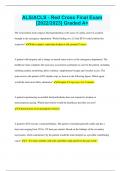Samenvatting
Samenvatting Cursus concepts of developmental biology
- Instelling
- Katholieke Universiteit Leuven (KU Leuven)
Alle hoofdstukken, uitgezonderd H14: Teratogens and birth defects. Dit is een cursus voor het vak 'concepts of developmental biology' gegeven aan de 3e bachelor Biomedische Wetenschappen (KUL). Dit wordt gedoceerd door prof. Zwijsen, prof. Callaerts en prof. Tylzanowski. Dit document bevat uitgebre...
[Meer zien]












